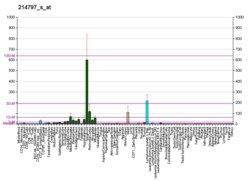PCTK3
Protein-coding gene in the species Homo sapiens
| CDK18 | |||||||||||||||||||||||||||||||||||||||||||||||||||
|---|---|---|---|---|---|---|---|---|---|---|---|---|---|---|---|---|---|---|---|---|---|---|---|---|---|---|---|---|---|---|---|---|---|---|---|---|---|---|---|---|---|---|---|---|---|---|---|---|---|---|---|
| Identifiers | |||||||||||||||||||||||||||||||||||||||||||||||||||
| Aliases | CDK18, PCTAIRE, PCTAIRE3, PCTK3, cyclin-dependent kinase 18, cyclin dependent kinase 18 | ||||||||||||||||||||||||||||||||||||||||||||||||||
| External IDs | OMIM: 169190; MGI: 97518; HomoloGene: 1949; GeneCards: CDK18; OMA:CDK18 - orthologs | ||||||||||||||||||||||||||||||||||||||||||||||||||
| |||||||||||||||||||||||||||||||||||||||||||||||||||
| |||||||||||||||||||||||||||||||||||||||||||||||||||
| |||||||||||||||||||||||||||||||||||||||||||||||||||
| |||||||||||||||||||||||||||||||||||||||||||||||||||
| |||||||||||||||||||||||||||||||||||||||||||||||||||
| Wikidata | |||||||||||||||||||||||||||||||||||||||||||||||||||
| |||||||||||||||||||||||||||||||||||||||||||||||||||
Serine/threonine-protein kinase PCTAIRE-3 is an enzyme that in humans is encoded by the CDK18 gene.[5][6]
References
- ^ a b c GRCh38: Ensembl release 89: ENSG00000117266 – Ensembl, May 2017
- ^ a b c GRCm38: Ensembl release 89: ENSMUSG00000026437 – Ensembl, May 2017
- ^ "Human PubMed Reference:". National Center for Biotechnology Information, U.S. National Library of Medicine.
- ^ "Mouse PubMed Reference:". National Center for Biotechnology Information, U.S. National Library of Medicine.
- ^ Okuda T, Cleveland JL, Downing JR (Dec 1992). "PCTAIRE-1 and PCTAIRE-3, two members of a novel cdc2/CDC28-related protein kinase gene family". Oncogene. 7 (11): 2249–58. PMID 1437147.
- ^ "Entrez Gene: PCTK3 PCTAIRE protein kinase 3".
Further reading
- Meyerson M, Enders GH, Wu CL, et al. (1992). "A family of human cdc2-related protein kinases". EMBO J. 11 (8): 2909–17. doi:10.1002/j.1460-2075.1992.tb05360.x. PMC 556772. PMID 1639063.
- Okuda T, Valentine VA, Shapiro DN, Downing JR (1994). "Cloning of genomic loci and chromosomal localization of the human PCTAIRE-1 and -3 protein kinase genes". Genomics. 21 (1): 217–21. doi:10.1006/geno.1994.1245. PMID 8088790.
- Strausberg RL, Feingold EA, Grouse LH, et al. (2003). "Generation and initial analysis of more than 15,000 full-length human and mouse cDNA sequences". Proc. Natl. Acad. Sci. U.S.A. 99 (26): 16899–903. Bibcode:2002PNAS...9916899M. doi:10.1073/pnas.242603899. PMC 139241. PMID 12477932.
- Ota T, Suzuki Y, Nishikawa T, et al. (2004). "Complete sequencing and characterization of 21,243 full-length human cDNAs". Nat. Genet. 36 (1): 40–5. doi:10.1038/ng1285. PMID 14702039.
- Herskovits AZ, Davies P (2004). "Cloning and expression analysis of two novel PCTAIRE 3 transcripts from human brain". Gene. 328: 59–67. doi:10.1016/j.gene.2003.12.011. PMID 15019984.
- Gerhard DS, Wagner L, Feingold EA, et al. (2004). "The status, quality, and expansion of the NIH full-length cDNA project: the Mammalian Gene Collection (MGC)". Genome Res. 14 (10B): 2121–7. doi:10.1101/gr.2596504. PMC 528928. PMID 15489334.
- Palmer KJ, Konkel JE, Stephens DJ (2005). "PCTAIRE protein kinases interact directly with the COPII complex and modulate secretory cargo transport". J. Cell Sci. 118 (Pt 17): 3839–47. doi:10.1242/jcs.02496. PMID 16091426.
- Rual JF, Venkatesan K, Hao T, et al. (2005). "Towards a proteome-scale map of the human protein-protein interaction network". Nature. 437 (7062): 1173–8. Bibcode:2005Natur.437.1173R. doi:10.1038/nature04209. PMID 16189514. S2CID 4427026.
- Kimura K, Wakamatsu A, Suzuki Y, et al. (2006). "Diversification of transcriptional modulation: large-scale identification and characterization of putative alternative promoters of human genes". Genome Res. 16 (1): 55–65. doi:10.1101/gr.4039406. PMC 1356129. PMID 16344560.
- Gregory SG, Barlow KF, McLay KE, et al. (2006). "The DNA sequence and biological annotation of human chromosome 1". Nature. 441 (7091): 315–21. Bibcode:2006Natur.441..315G. doi:10.1038/nature04727. PMID 16710414.
- Herskovits AZ, Davies P (2006). "The regulation of tau phosphorylation by PCTAIRE 3: implications for the pathogenesis of Alzheimer's disease". Neurobiol. Dis. 23 (2): 398–408. doi:10.1016/j.nbd.2006.04.004. PMID 16766195. S2CID 39038607.
- Wissing J, Jänsch L, Nimtz M, et al. (2007). "Proteomics analysis of protein kinases by target class-selective prefractionation and tandem mass spectrometry". Mol. Cell. Proteomics. 6 (3): 537–47. doi:10.1074/mcp.T600062-MCP200. hdl:10033/19756. PMID 17192257.
- v
- t
- e
Serine/threonine-specific protein kinases (EC 2.7.11.21-EC 2.7.11.30) | |||||||||||||||||||||
|---|---|---|---|---|---|---|---|---|---|---|---|---|---|---|---|---|---|---|---|---|---|
| |||||||||||||||||||||
Dual-specificity kinases (EC 2.7.12) | |||
|---|---|---|---|
| |||
 | This article on a gene on human chromosome 1 is a stub. You can help Wikipedia by expanding it. |
- v
- t
- e




















